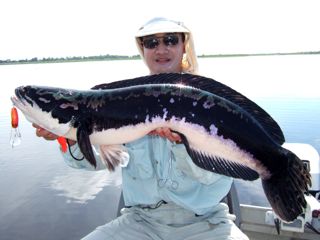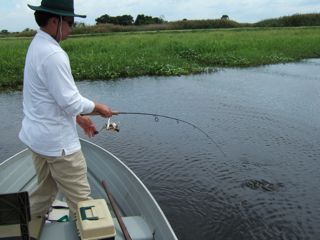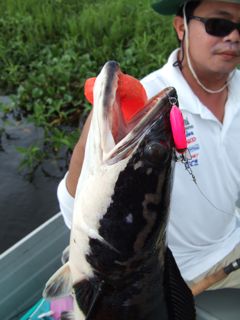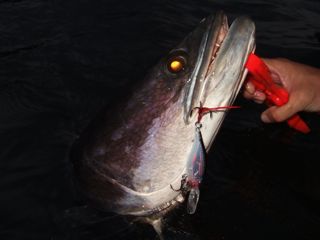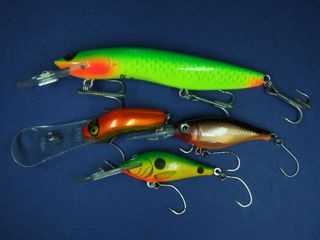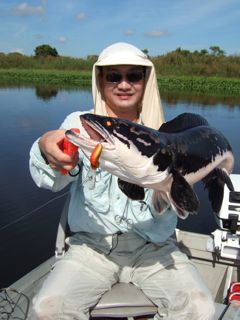
Smaller is better
The splashing by the edge of the water hyacinths attracted our attention. The quick sharp splashes made Lawrence and me immediately reach for our sebarau tackle as we steered the boat into casting range. Our small lures sailed out through the light rain to where the commotion had been made.
As soon as our lures landed, we were both hit simultaneously, double hook up! In a short while the hard pulling fish emerged and we were both taken aback when we realised that the two fish we had hooked up were toman! They were juvenile toman just over a kilo. They sure did pull hard and fed like a pack of sebarau too.
The most remarkable thing was that the lure I was using was extremely small, no bigger than a one cent coin and the tiny size 10 hooks of the minute lure managed to hook up beautifully in the upper lip of the jaw. If the toman had inhaled the lure another centimetre I would have less one lure.
Another time we were working the rocky edge of a steep jungle drop off in a reservoir in a mountainous area. We were using some small 5 cm deep divers, happily hooking up sebarau when suddenly something big grabbed my little crankbait and tore off.
I had some heart stopping moments when the fish headed towards an overhanging tree, close to snagging up on the submerged branches. The beats of the tail of the struggling fish could be felt clearly but moments later it was dragged out into the open water for a clean fight. When it neared the boat it showed itself clearly in a dramatic manner.
If you have ever seen the TV shots of an intercontinental missile being shot out of the water by a submerged submarine you can imagine what we saw. In this case instead of a rocket propelled missile, it was a big toman leaving the water vertically like a missile, totally clearing the water!
This was another big catch on a small lure. Again I was lucky it did not just swallow the whole lure, chomping down on the leader and biting off my Tilsan bass.
On another occasion I was not so lucky. Neoh and I were fishing from my canoe for haruan and toman. I heard a toman rise behind me. Looking over my shoulder I saw a big toman sinking back down behind me. Tossing my brush jig over my shoulder it landed at the side of the toman.
The toman obviously noted the entry of the jig at its side, as it made a u-turn and gulped down the jig as I cranked as fast as I could, but I never did get the line tight to set the lure in the jaw with the line safely outside the mouth. I just ended up reeling in the line cleanly cut off near the jig head. That is the danger of using small lures. The possibility of getting bitten off is higher than when using larger lures. Or is it?
Though I have been bitten off on lures a few times by toman, it actually has not been that often. I think I have only lost two or maybe three lures due to a bite off. Strangely enough, other than the brush jig, I have not lost any small lures to bite offs by toman.
When we go fishing, looking for big toman, we normally rig up with big lures, subscribing to the common belief of big lure, big fish. Surely that is just plain common sense, isn’t? It sure makes sense to me. Plus the fact that a bigger lure should be harder to bite off if one is not using a wire leader, which is how I rig my gear. I do not use a wire leader when toman hunting, but just a straight mono leader to the lure with swivel and snap to attach the line to the lure for quick lure changes.
Another reason we have normally preferred bigger lures is that they are heavier and easier to cast than the small lures. Heavier lures allow the use of more powerful rods, reels and line, whereas lighter lures need to be balanced with lighter and less powerful tackle to be easily cast. Additionally, the larger lures have stronger hooks. Small lures need the hooks to be upgraded to stronger hooks without compromising the swimming action of the light lure.
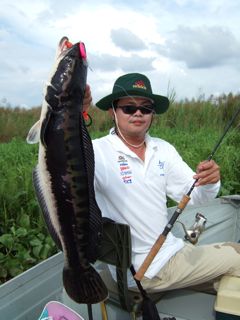 Every time we fish in a toman area, I grab for the rod rigged up with the heavy tackle set up with big lures. Or, when a school of toman fry is sighted, we quickly change to the bigger lures. A bigger lure is a simulation of a fuller meal, and there is less chance of the toman’s teeth coming in contact with the line. Yet, on hindsight, funnily enough, all my biggest toman have been caught on relatively small lures. Most of them were around 5 cm in body length. Not only have they been my own catches but other fishing companions of mine have experienced such catches too.
Every time we fish in a toman area, I grab for the rod rigged up with the heavy tackle set up with big lures. Or, when a school of toman fry is sighted, we quickly change to the bigger lures. A bigger lure is a simulation of a fuller meal, and there is less chance of the toman’s teeth coming in contact with the line. Yet, on hindsight, funnily enough, all my biggest toman have been caught on relatively small lures. Most of them were around 5 cm in body length. Not only have they been my own catches but other fishing companions of mine have experienced such catches too.
Some of the catches have taken place when I was casting to a school of toman fry. Once in a former mining pond, when trolling for peacock bass, a school of toman fry was spotted and the engine was quickly put into idle. The only rod rigged up was the one I had on so I cranked in the lure as fast as I could. It was an extra deep diving little lure, a Halco Poltergeist +8m. I did not want to waste time changing to a larger lure but I was doubtful that this small 5 cm crash dive lure would be attractive to the parents, but it was the quickest option.
As soon as the trolled lure was retrieved, it was sent sailing into the air where it landed slightly to the side of the main school of toman fry. I still felt that a bigger lure would have been more appropriate as a bigger lure would be more intimidating to the fry but to my surprise within a few cranks the lure came to a stop and I was fighting something big and heavy that was pulling the boat to the weedy bank! The hooks on this lure were beefy single hooks so I was able to put some grunt into the fight but yet it still took some time to subdue this toman.
On the same day and at the same place, Peter was casting and happily catching peacock bass with a small 3.5 cm Halco sorcerer. I myself continued to watch him do most of the catching that afternoon as I was after bigger fish with a bigger 9 cm lure. My effort of course was not productive. Peter cast to the edge of the water hyacinths and hooked up a fish that gave him a real run for his money on his light spin tackle. It was of course a big toman in proportion to the size of his lure and his light tackle. It was neatly hooked up by the tail hook on the upper lip. It was a wonder that it had not been bitten off.
Another reason why we have normally preferred bigger lures is that they are heavier and easier to cast than the small lures. Heavier lures allow the use of more powerful rods, reels and line, therefore we can apply more heavy pressure on big toman to land them successfully. However, lighter lures need to be balanced with lighter and less powerful tackle to be easily cast. Additionally, the larger lures have stronger hooks. Small lures need the hooks to be upgraded to stronger hooks without compromising the swimming action of the light lure.
My wife caught a nice big toman of 6.8 kgs in a fishing competition a few years back. Remarkably it was caught on a small 7 cm Rapala Taildancer. We were canoeing in a small inlet and there was a swirl by the edge of the grassy bank and her cast there was taken within a few turns of the handle. The fight went on for a good 10 minutes on “light tackle” before it was netted. It was her first ever toman caught and it was bigger than anything I had ever caught myself at the time!
I did not foresee myself capping this catch with a better one at any time in the immediate future with the overfished waters we have here, but to my surprise and joy I was fortunate enough to exceed this six months later. We were enjoying ourselves with some small toman, and figured that we would make it more challenging by going for them with light lines and if we could break some IGFA world records, why not?
Because we were using light lines and not targeting monsters, we were not using big lures but the smaller ones. I was using a 8 cm lure, which by most standards is not that small a lure for freshwater use, but considering the size of the toman it caught, the Tilsan barra in comparison became very small. The landing net too had problems trying to fit the big fish. The 10 kg toman really dwarfed the 8 cm lure!
To date I still wonder why I have not caught these big fish on the big 12 cm lures I normally use when looking for big toman. Could it possibly be that their normal diet is baitfish smaller than 5 cm? Sure we have seen some big 20 cm long fish or even 40 cm long fish with their body\ies chopped in half by “something big”, possibly a monstrous toman. But then maybe the smaller baitfish are more common and therefore create a stronger instinctive strike when the small lure is presented right in a toman’s face?
We can surmise this issue endlessly, but “the proof is in the pudding”. My most recent catch where I was using the new 6 cm X-Rap Shad for the first time, looking for sebarau but instead, I hooked up a monstrous toman. This small lure had just hit the water and it had only moved two metres when it was slammed. Immediately I knew this was not a small fry. It had power and weight behind it.
It ran towards some old submerged logs where I had to do my utmost to prevent it from reaching freedom. The treble hooks on these small lures are generally weaker than I prefer, so I normally replace them with stronger hooks. To keep the hook weight similar to the original hooks so as to not affect the action of the lure, these stronger hooks need to be single hooks.
However with this lure, it was fresh out of the box on a trial run and I had not upgraded the hooks yet. I was fearful that they would open up and the fish would get away scot free. It was tempting to increase the drag to stop the fish. Instead, smooth gentle rod work was the only option. Incredibly that worked and the fish turned away from the snag and was now fighting near the boat which had been positioned in deep water far from the known snags.
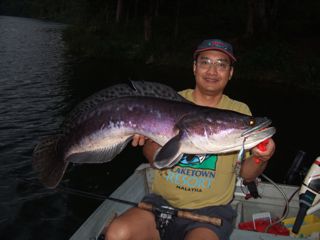 The fish jumped once, confirming that it was a toman and not a monstrous sebarau. It still tried heading for another snag but it was becoming tired and was able to be kept from reaching the snag. When it tired, it was quickly netted and the trophy fish was “in the bag”! We were amazed at the comparative size of the toman to the small lure and also that it had not escaped, because one of the treble hooks had opened up a little.
The fish jumped once, confirming that it was a toman and not a monstrous sebarau. It still tried heading for another snag but it was becoming tired and was able to be kept from reaching the snag. When it tired, it was quickly netted and the trophy fish was “in the bag”! We were amazed at the comparative size of the toman to the small lure and also that it had not escaped, because one of the treble hooks had opened up a little.
It was a good thing the reel I was using had its drag upgraded to carbon-tex washers coated with Cal’s drag grease. The drag upgrade released the line very, very smoothly without any juddering. I believe that if the drag system had not been in top notch condition, the light hooks might have opened further if the drag had been jerky or the hooks might have been completely jerked off.
I think I need to review my thinking of big lure equals big toman. Historically from what I have experienced and seen, this does not seem to be always so. Maybe now when I fish in big toman country I should consider the option of putting on small lures instead. This is food for thought and further trials are needed to see if this conjecture holds water consistently, though so far it has. Maybe toman these days have changed their preferences and fall prey more easily to small lures, compared to the toman in the days gone by.
Conservation
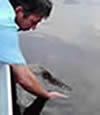
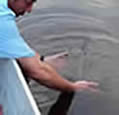
We need to protect and conserve our resources by practising catch and release of our sportfish and protecting the habitat of our fishes.
